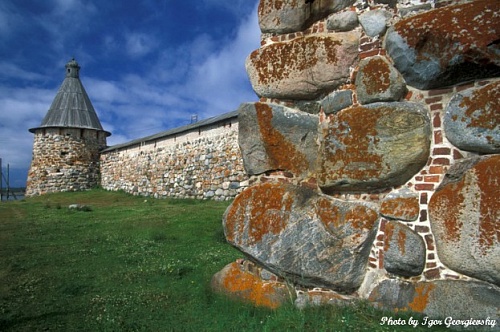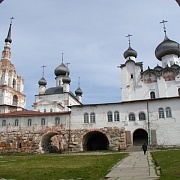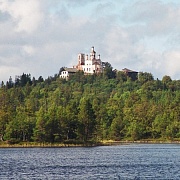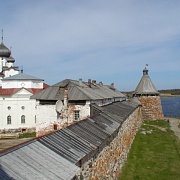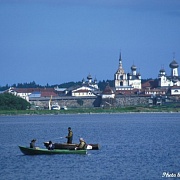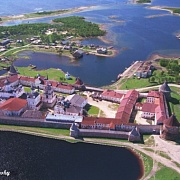Solovetsky Monastery is situated in the western part of the White Sea, less than 100 miles from the Polar Circle, and consists of 6 big and many small islands. The biggest is the Greater Solovetsky Island, on which the famous medieval monastery stands.
When visiting Solovetsky Islands, you get acquainted with legendary Monastery buildings and fortress walls and towers, learn the history of the infamous Stalin's prison SLON.
You can see numerous hermitages in different parts of the Island, the monastery drydock, stone labyrinths of prehistoric times, take an exciting boat trip along the intricate canal system of the Island, connecting it's largest lakes. The nature wonders of the Island are spectacular, and it's botanical garden introduces many plant species. The archipelago is a place of inhabitation of white whales, or belugas, thriving in the wild. A shore-based whalewatching or boat whalewatching is a never-to-be forgotten experience.
History of the island
The habitation of the Karelian coast of the White Sea began in the 12-13th centuries when fishermen and hunters from Novgorod settled down in this area. Monks were the next to move there. Local inhabitants new about the Islands in the sea, and told about it to the old monk Savvaty. Savvaty at that time was looking for loneliness after the death of his teacher Kiril Belozersky and travelled in the north of Russia. For some time he lived in Valaam Monastery, but found it overcrowded and went away far to the north. In 1429, he reached the Solovetsky Islands.
Savvaty was later respected as the pioneer on the Islands, but it was not him who established the monastery. In 1436, Zosima, a son of rich parents lived on the shore of the Lake Onego (near Kizhi). One day he decided to devote the rest of his life to monkery and gave out all his property to poor men. Zosima and his team of followers landed on The Solovetsky Islands and established a monastery.
Until to the middle of the 16th century the Solovetsky monastery was alike other small-sized monasteries in the north. But in 1549 the Monastery got a new leader Fillip, who was an energetic and outstanding person. Under his leadership the Monastery started building stone temples, new roads, canals to connect it numerous lakes.
That time the Monastery began to play an important role in the defense of the north of Russia. In 1582-1594 a new fortress was erected on the Island by monks upon the order of Tzar. It was built of huge boulders and became one of the biggest and most powerful Russian fortresses. For many centuries the fortress and its garrison guarded the border.
In the middle of the 17th century, the Monastery's political and moral influence on Russian life became very strong. And that time the Monastery authorities started to resist the religious reforms of the Russian Church supported by Tzar. Peace negotiations gave no results and Tzar sent army forces to punish the rebels. It was time of the famous "Solovetsky siege" (1668-1676). The strong and well equipped army managed to capture the Monastery only with the help of a traitor in January 1676. The punishment was very cruel and many monks were executed. This was the only time in the Monastery's history when it was occupied.
Another military attack took place in 1854. It was the time of the Crimean War. On 6th of July 1854, two British 60-cannon frigates "Brisk" and "Miranda" approached the Island. The skirmish started. The ships made about 1800 shoots at the monastery within 9 hours. The surprising result was that there were no human casualties after such an intensive fire and only a few buildings were slightly damaged.
Solovetsky Monastery was often used as a prison for criminals and heretics. In 1923, a infamous prison SLON (Solovetsky Camp of Special Purpose) was set up. Hundreds of thousands prisoners were kept on the Island. They suffered badly and many of them died. The prison was closed in the 1939.
Since 1965 the restoration works in the Solovetsky Kremlin has been going on. In 1974 Solovetsky museum was opened.
How to get:
-
Boat from Kem or Belomorsk;
-
Helicopter from Petrozavodsk or Arkhangelsk in winter.

